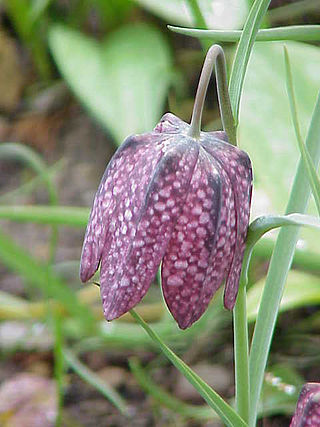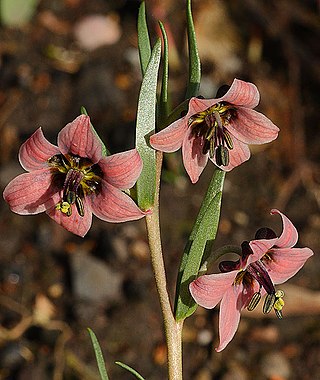
Fritillaria (fritillaries) is a genus of spring flowering herbaceous bulbous perennial plants in the lily family (Liliaceae). The type species, Fritillaria meleagris, was first described in Europe in 1571, while other species from the Middle East and Asia were also introduced to Europe at that time. The genus has about 130–140 species divided among eight subgenera. The flowers are usually solitary, nodding and bell-shaped with bulbs that have fleshy scales, resembling those of lilies. They are known for their large genome size and genetically are very closely related to lilies. They are native to the temperate regions of the Northern hemisphere, from the Mediterranean and North Africa through Eurasia and southwest Asia to western North America. Many are endangered due to enthusiastic picking.

Carl Peter Thunberg, also known as Karl Peter von Thunberg, Carl Pehr Thunberg, or Carl Per Thunberg, was a Swedish naturalist and an "apostle" of Carl Linnaeus. After studying under Linnaeus at Uppsala University, he spent seven years travelling in southern Italy and Asia, collecting and describing people and animals new to European science, and observing local cultures. He has been called "the father of South African botany", "pioneer of Occidental Medicine in Japan", and the "Japanese Linnaeus".

Friedrich Anton Wilhelm Miquel was a Dutch botanist whose main focus of study was on the flora of the Dutch East Indies.

Fritillaria camschatcensis is a species of flowering plant native to northeastern Asia and northwestern North America, including northern Oregon, Washington, British Columbia, Alaska, northern Japan, and the Russian Far East. It has many common names, including Kamchatka fritillary and Kamchatka lily.

Polygonatum odoratum, the angular Solomon's seal or scented Solomon's seal, is a species of flowering plant in the family Asparagaceae, native to Europe, the Caucasus, Siberia, the Russian Far East, China, Mongolia, Korea, Nepal and Japan. In the United Kingdom it is one of three native species of the genus, the others being P. multiflorum and P. verticillatum.

Fritillaria verticillata is a flowering plant in the lily family Liliaceae, native to Japan, Korea, Mongolia, Xinjiang, Kazakhstan and the Altay region of Siberia.
Croomia japonica is a plant species native to China and Japan. It grows in mixed forests.

Allium thunbergii, Thunberg's chive or Thunberg garlic, is an East Asian species of wild onion native to Japan, Korea, and China. It grows at elevations up to 3000 m. The Flora of China recognizes A. tunbergii and A. stenodon as separate species, but more recent sources combine the two.
Fritillaria cirrhosa, common name yellow Himalayan fritillary, is an Asian species of herbaceous plant in the lily family, native to China, the Indian Subcontinent, and Myanmar.

Fritillaria karelinii is an Asian species of herbaceous perennial plant in the lily family Liliaceae, native to Kazakhstan, Kyrgyzstan, Tajikistan, Uzbekistan, Turkmenistan, Iran, Pakistan, and Xinjiang.

Fritillaria meleagroides is a Eurasian species of flowering plant in the lily family Liliaceae, native to Xinjiang, Russia, Kazakhstan, Ukraine, and Bulgaria.
Fritillaria monantha is a Chinese plant species in the lily family Liliaceae. It is found only in China, in the Provinces of Anhui, Henan, Hubei, Jiangxi, Sichuan, and Zhejiang.
Fritillaria taipaiensis is a flowering plant species in the lily family Liliaceae. It is found only in China, in the Provinces of Gansu, Hubei, Shaanxi and Sichuan.
Fritillaria tortifolia is a flowering plant species in the lily family Liliaceae. It is found only in the northwestern part of Xinjiang Province, the extreme northwestern corner of China.

Fritillaria ussuriensis is a species of flowering plant in the lily family Liliaceae, native to Korea, the Primorye Region of Russia, and northeastern China.
Fritillaria walujewii is a species of flowering plant in the lily family Liliaceae, native to Kazakhstan, Kyrgyzstan, and Xinjiang Province in western China.
Fritillaria yuminensis is a plant species native to the northwestern part of Xinjiang Province in northwestern China. It grows in open grassy hillsides at elevations of 1,000–3,500 m (3,300–11,500 ft).
Quercus oxyodon is a tree species in the beech family Fagaceae. It is native to the Himalayas and to the mountains of southern China and the Sa Pa region of northern Vietnam. It is placed in subgenus Cerris, section Cyclobalanopsis.

Fritillaria japonica is a perennial herbaceous bulbous plant, endemic to Japan. It is a species in the genus Fritillaria, in the family Liliaceae. It is placed in the subgenus Japonica.

Astilbe thunbergii is a species of flowering plant in the genus Astilbe, native to Japan. Its hybrid cultivar 'Straussenfeder' has gained the Royal Horticultural Society's Award of Garden Merit.












